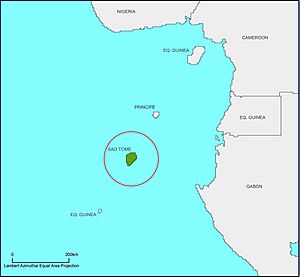Schistometopum thomense facts for kids
Quick facts for kids Schistometopum thomense |
|
|---|---|
 |
|
| Conservation status | |
| Scientific classification | |
| Genus: |
Schistometopum
|
| Species: |
thomense
|
 |
|
| range | |
The Schistometopum thomense is a special kind of amphibian that looks a bit like a worm or a snake. It's often called the São Tomé caecilian or the island caecilian. This amazing creature lives only on the islands of São Tomé and Ilhéu das Rolas. When an animal lives only in one specific place, we say it is endemic to that area.
You can find the São Tomé caecilian in many different places on São Tomé. It lives in most types of soil, from wet lowland forests to coconut farms near the coast. The only places it doesn't live are the very dry northern parts of the island. These caecilians are usually about 30 centimeters (12 inches) long. They are often a bright yellow color!
Contents
About the São Tomé Caecilian
The size of the São Tomé caecilian can change depending on where it lives on the island. This is because São Tomé is a huge volcano, so it has many different heights and temperatures.
How Its Size Changes
The São Tomé caecilian is the only known caecilian that follows something called Bergmann's rule. This rule usually applies to warm-blooded animals. It says that in colder places, animals tend to be bigger. For the São Tomé caecilian, this means that in cooler, higher parts of the island, they might grow larger. This is why you can find different sizes of this caecilian across São Tomé.
Other Names for This Caecilian
People have given this caecilian a few different names over time. Besides the São Tomé caecilian, it's also been called the Agua Ize caecilian or the island caecilian. Locally, on the islands, people sometimes call it cobra bobo.
Its Family Tree
Scientists study how different animals are related to each other. This is like building a family tree for all living things. For the São Tomé caecilian, scientists have looked at its DNA to understand its relatives.
Relating to Other Caecilians
The São Tomé caecilian belongs to a group of caecilians called Schistometopum. This group is closely related to another group called Dermophis, which lives in South America. Think of them as cousins!
Within its own Schistometopum group, the São Tomé caecilian is a close relative of S. gregorii. This other species lives far away in East Africa, in countries like Kenya and Tanzania.
New Discoveries
Recently, scientists found a new, very similar species on São Tomé Island. They named it Schistometopum ephele. It looks so much like the São Tomé caecilian that it's called a "cryptic species." This means it's hard to tell them apart just by looking. Scientists are still learning more about how these two species are related. They think that the common ancestor of S. thomense and S. ephele separated from S. gregorii about one million years ago.
How Scientists Classify Caecilians
For a long time, scientists grouped the São Tomé caecilian with many other caecilians in a large family called Caeciliidae. But in 2011, they updated the way they classify caecilians. Now, caecilians are divided into nine different families. The Schistometopum group, which includes the São Tomé caecilian, is now placed in the family Dermophiidae. This new classification helps scientists understand the relationships between all caecilians much better.


